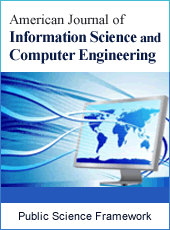American Journal of Information Science and Computer Engineering
Articles Information
American Journal of Information Science and Computer Engineering, Vol.1, No.1, May 2015, Pub. Date: May 14, 2015
Interference Management in MIMO-OFDM-Based Emerging Wireless Systems
Pages: 1-9 Views: 6444 Downloads: 1510
[01]
Isiaka A. Alimi, Department of Electrical and Electronics Engineering, School of Engineering and Engineering Technology, Federal University of Technology, Akure, Nigeria.
[02]
Jide J. Popoola, Department of Electrical and Electronics Engineering, School of Engineering and Engineering Technology, Federal University of Technology, Akure, Nigeria.
[03]
Kayode F. Akingbade, Department of Electrical and Electronics Engineering, School of Engineering and Engineering Technology, Federal University of Technology, Akure, Nigeria.
[04]
Michael O. Kolawole, Department of Electrical and Electronics Engineering, School of Engineering and Engineering Technology, Federal University of Technology, Akure, Nigeria.
Despite the limited bandwidth resource and exponential growth in the number of subscribers, the requirement for high quality wireless communication coupled with higher data rates increases with various emerging multimedia applications. In the light of this, the challenge is managing the available spectrum efficiently. As such, an increase in the spectral efficiency implies ability to have greater throughput in the same amount of spectrum, and by implementing appropriate advanced technologies; the spectrum efficiency of wireless communication systems can be improved. It has been established that technologies such as orthogonal frequency division multiplexing (OFDM) and multiple input, multiple output (MIMO) systems, can enhance the performance of the emerging wireless communication systems significantly in terms of data rates and channel capacity in rich-scattering environments. To achieve the required efficiency, multi-user detection is of paramount importance in MIMO-OFDM systems to reduce signal interference such as multiuser interference. In this paper, both linear and nonlinear detection algorithms are broadly analysed and low-complex hybrid interference detection (HID) scheme is proposed. The proposed algorithm performance is estimated in terms of bit error rate (BER) and simulation results show near optimal performance.
BER, HID, ICD, MUD, SIC, SQRD
[01]
H. Lee, B. Lee, and I. Lee, “Iterative detection and decoding with an improved V-BLAST for MIMO-OFDM systems”, IEEE Journal on Selected Areas in Communications, vol. 24, no. 3, pp. 504-513, 2006.
[02]
I. A. Alimi, J. J. Popoola, K. F. Akingbade and M. O. Kolawole, “Performance analysis of bit-error-rate and channel capacity of MIMO communication systems over multipath fading channels”, International Journal of Informatics and Communication Technology, vol. 2, no. 2, pp. 57-63, 2013.
[03]
V. S. Annapureddy, and V. V. Veeravalli, “Sum capacity of MIMO interference channels in the low interference regime”, IEEE Transactions On Information Theory, vol. 57, no. 5, pp. 2565-2581, 2011.
[04]
C. Teekapakvisit, V. D. Pham, and B. Vucetic, “An Adaptive Iterative Receiver for Space-Time Coding MIMO Systems”, Journal of Telecommunications and Information Technology, vol. 1, pp. 54-59, 2006.
[05]
J. Lee, J. K. Han, and J. Zhang, “MIMO technologies in 3GPP LTE and LTE-advanced”, EURASIP Journal on Wireless Communications and Networking, vol. 2009, pp. 1-10, 2009.
[06]
V. Namboodiri, H. Liu and P. Spasojevic´, “Successive interference cancelation and MAP decoding for mobile MIMO OFDM systems and their convergence behavior”, EURASIP Journal on Wireless Communications and Networking, vol. 311, pp. 1-12, 2012.
[07]
M. Konrad and W. Gerstacker, Interference robust transmission for the downlink of an OFDM-based mobile communications system, EURASIP Journal on Wireless Communications and Networking vol. 2008, pp. 1-14, 2008
[08]
V. J. Naveen, K. M. Krishna and K. R. Rajeswari, “Performance analysis of equalization techniques for MIMO systems in wireless communication”, International Journal of Smart Home vol. 4, no. 4, pp. 47-63, 2010.
[09]
P. Hiral, S. Minal and A. Aniruddh, “Comparative study approach for MIMO-OFDM using spatial multiplexing techniques”, International Journal of Advanced Engineering Research and Studies, vol. II, issue II, pp. 32-35, 2013.
[10]
M. Jiang and L. Hanzo, “Multiuser MIMO-OFDM for next-generation wireless systems”, Proceedings of the IEEE, vol. 95, no. 7, pp. 1430-1469, 2007.
[11]
D. Chang and D. Guo, "Spatial-Division Multiplexing MIMO Detection Based on a Modified Layered OSIC Scheme," IEEE Transactions on Wireless Communications, vol.12, no.9, pp.4258-4271, 2013.
[12]
A. Paulraj, R. Nabar and D. Gore, Introduction to Space-Time Wireless Communications. Cambridge University Press, 2003.
[13]
P. W. Wolniansky, G. J. Foschini, G. D. Golden and R. A. Valenzuela, “V-BLAST: an architecture for realizing very high data rates over the rich-scattering wireless channel”, URSI ISSSE’98, Pisa, Italy, pp. 295-300, 1998.

ISSN Print: 2381-7488
ISSN Online: 2381-7496
Current Issue:
Vol. 7, Issue 3, September Submit a Manuscript Join Editorial Board Join Reviewer Team
ISSN Online: 2381-7496
Current Issue:
Vol. 7, Issue 3, September Submit a Manuscript Join Editorial Board Join Reviewer Team
| About This Journal |
| All Issues |
| Open Access |
| Indexing |
| Payment Information |
| Author Guidelines |
| Review Process |
| Publication Ethics |
| Editorial Board |
| Peer Reviewers |


